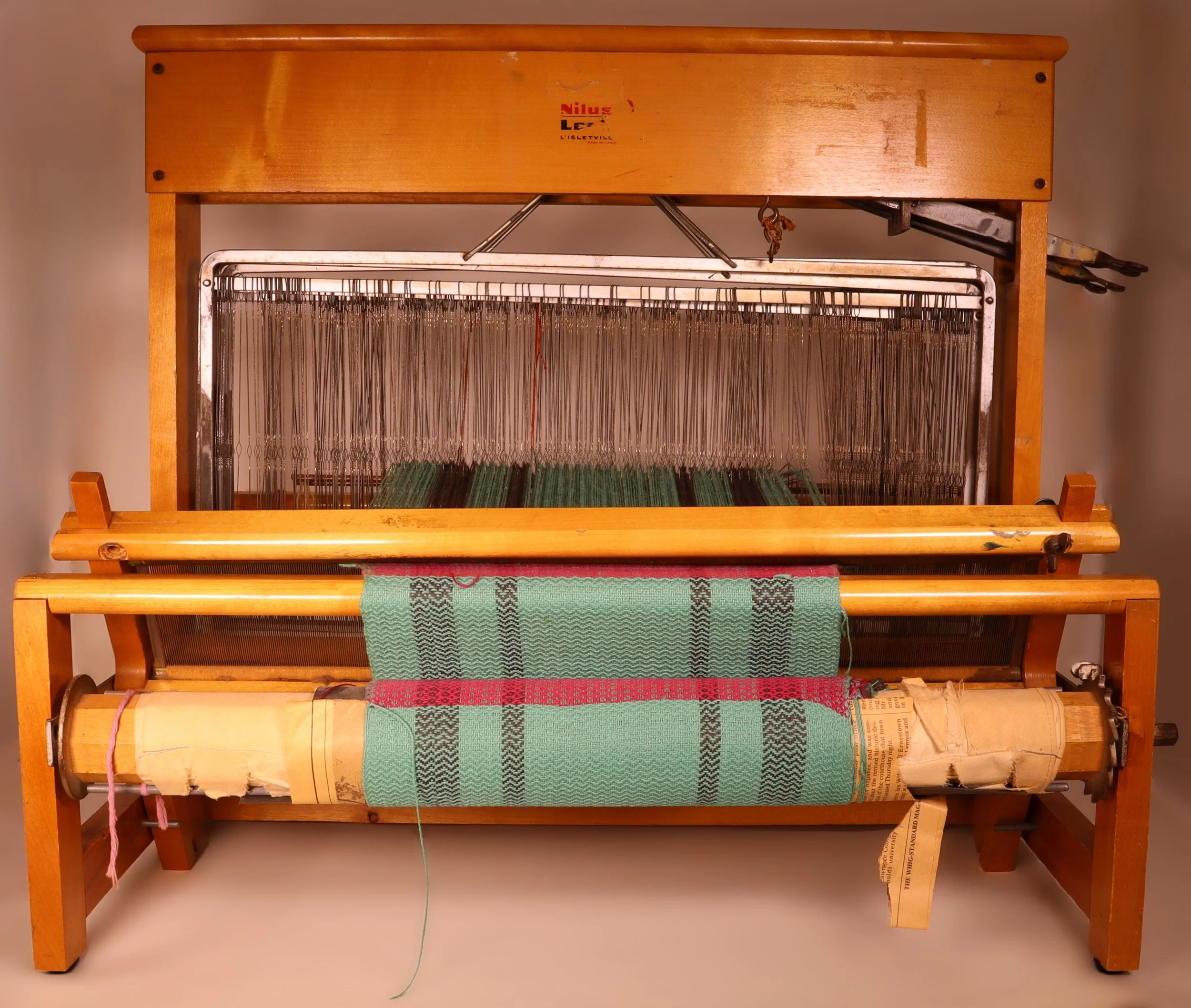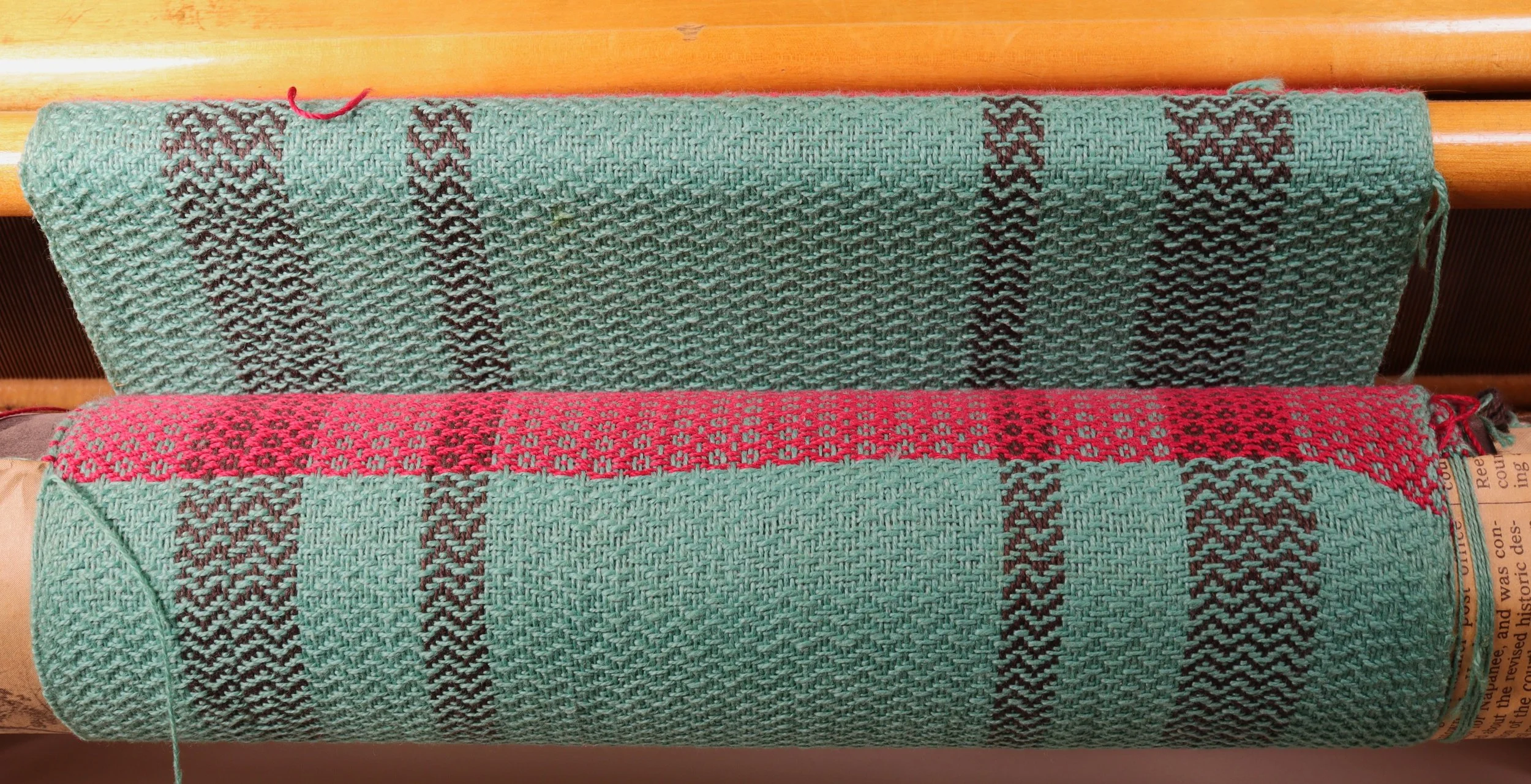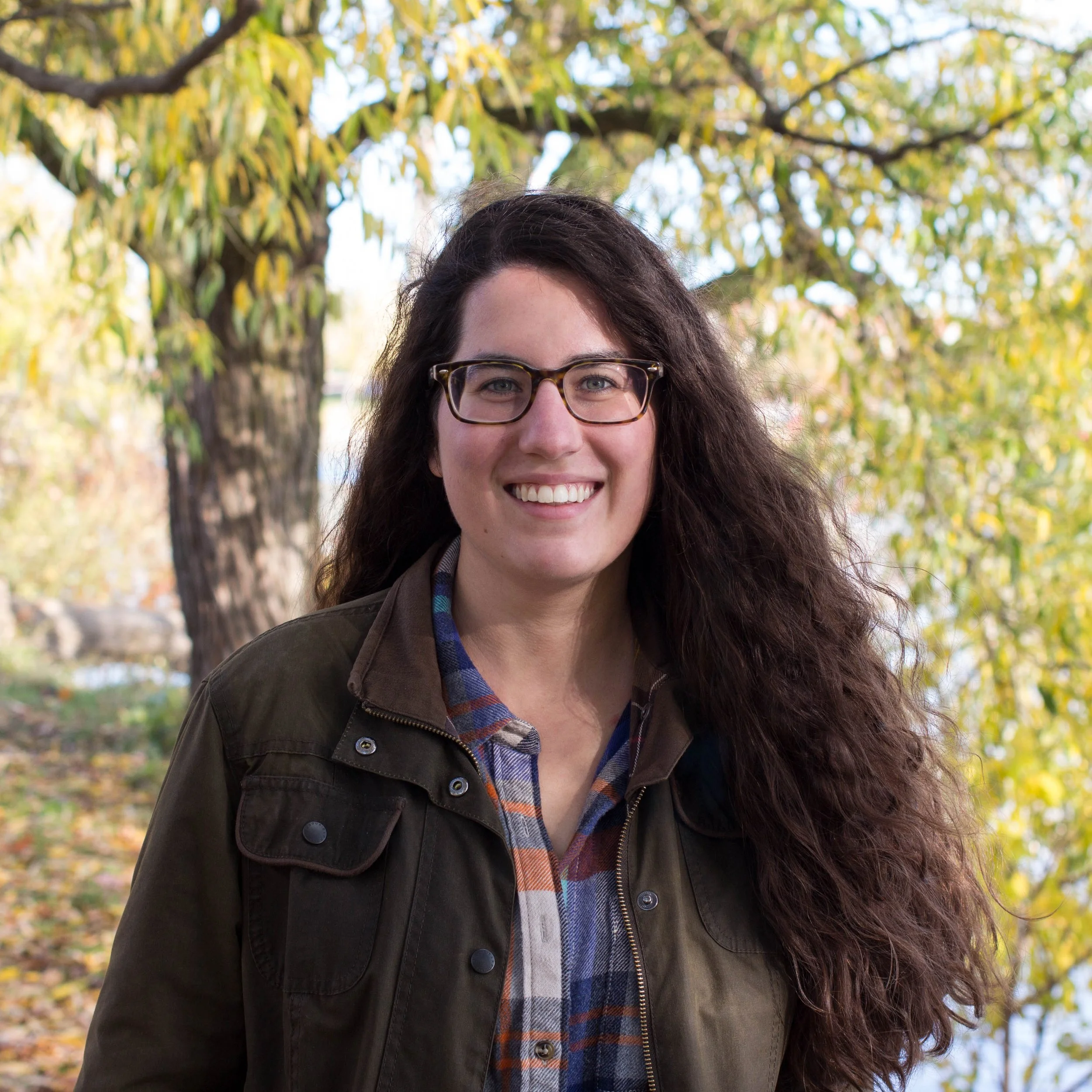Warp and Weft: An Exploration of the Leclerc Jano Loom and Weaving in Occupational Therapy
A Leclerc Jano loom provided the inspiration for my Margaret Angus Fellowship research about the history of occupational therapy. The loom almost seems out of place amongst the pill bottles, doctors’ kits, and nurses’ uniforms that surround it in the museum’s storage room (Figure 1). Objects in the MHC’s collections often bear the imprint of the doctors, nurses, and other health care professionals who touched and used the equipment, but only infrequently bear the traces of the patients that these objects served. While little is known about this Jano loom, it stood out to me because it holds a half-finished project likely created by a patient of the Kingston Psychiatric Hospital, leaving behind a trace of the patient who wove it.
As part of my project this summer, I decided to recreate the woven fabric on the Jano loom from the Kingston Psychiatric Hospital. Using a second-hand Jano loom and cotton purchased from the Quebec weaving materials company Brassard & Fils, I am currently in the process of weaving a replica of the fabric, which will be donated to the collections of the Museum of Heath Care for use in their exhibits and education programs. In this blog post, I discuss the history of this loom and how weaving was used in occupational therapy during the 1950s and 1960s, when it was likely purchased for use in the hospital. Read on to the end of the post for a special invitation to participate in this project!
The Leclerc Company, the Jano Loom, and Weaving Therapy
Today, handweavers are familiar with Leclerc, a handloom company that has been manufacturing looms for home use in Canada for more than a century. The Leclerc Company, originally called Alfred Leclerc and Sons, was founded in St. Cyrille, Quebec in 1874 by Alfred Leclerc. Although it began as a flour milling company, Leclerc always maintained a connection to textiles. The mill that Alfred Leclerc purchased also contained a wool carder and through the late nineteenth and early twentieth centuries, the company produced both flour and wool products.[1]
Figure 1: The Leclerc Jano loom in the Museum of Health Care’s collections. Museum of Health Care #000003390
In 1924, under the direction of Alfred’s son Léonius (known as Nilus), the company unveiled their first home handloom at the Quebec Exhibition, where Émélie Chamard, a prominent weaver and textile educator, demonstrated weaving techniques on the new loom for the public.[2] The demonstration was wildly successful and the company began designing new models. In the late 1930s, the Jano loom was introduced. It was Leclerc’s first table loom and was relatively small (20 inches of weaving width) and portable, making it ideal for weaving at home.[3] During World War II, the company designed looms specifically for use in rehabilitation therapy programs in Canada, the United States, and Great Britain.[4] In the 1943 Leclerc catalogue, the Jano loom is described as “smaller,” “lighter,” and “more easily moved” than other models, but with “all of the advantages” of the company’s larger floor looms.[5] The catalogue listing advertised the Jano as offering a greater range of pattern options and the loom was controlled completely by the hands, as opposed to floor looms that required weavers’ to use both feet and hands.[6] These attributes made the Jano loom well suited for use in occupational therapy programs.
We do not know when this particular Jano loom was purchased by the Kingston Psychiatric Hospital. However, the company logo, styled as “Nilus Leclerc, l'Isletvill, Made in Canada,” in red and black stamped on the top of the loom suggests that it was made in the 1950s or 1960s, certainly at some point before the late 1960s, when Jano looms were discontinued by the company.[7] By this time, weaving was still a core craft practiced by occupational therapists, though treatment trends were changing. As early as the 1930s, occupational therapy had been criticized by other health care professionals for its lack of scientific foundation.[8] Following the World Wars, occupational therapists had taken on diverse roles in private and public hospitals, veteran services, pediatric medicine, and mental health services, which pressured the field to develop a methodology more in line with other health care professions.[9] Three major treatment models influenced occupational therapy in the post-war period: psychoanalysis, kinesiology, and neurology, with treatments that were specifically tailored to patients’ needs.[10] As therapist Mary Fiorention explained: “The body of knowledge and expertise the occupational therapist has at her command are far too important in preparing a child to cope with his environment to be relegated to the realm of relaxation with craft activities.”[11]
During this period, weaving was used to treat illnesses and injuries that caused muscle loss, including tuberculosis and poliomyelitis, paralysis, and spinal injuries.[12] In one example of a treatment program from the 1950s, weaving was used to test one woman’s progress as she underwent a physical therapy program.[13] Her occupational therapist provided her with a frame loom and gradually increased her working time while decreasing her rest time to gauge her overall progress.[14] As the article notes, arm strength allows the patient to eventually be able to move a wheelchair, or use crutches, or hold onto handrails while using stairs, all factors important to a patients’ ability to navigate through the world following their time in hospital.[15] Occupational therapists also frequently made alterations to looms to support a specific treatment plan for their patients. Slings were used for patients who could not lift their arms unassisted to move the loom’s beater or throw the shuttle. Handles could be attached to the beater for easier gripping, and weight could be added to the beater or foot treadles for greater resistance to work on the muscles of the legs and arms.
As this Jano loom was used in a psychiatric setting, it is more likely that weaving in this context was part of a larger treatment plan designed by psychiatrists and occupational therapists. Wound onto the back beam, keeping the threads evenly tensioned, is a copy of the Kingston newspaper The Whig-Standard dated February 3, 1993, meaning that this loom was last used just over thirty years ago. In 2001, when Kingston Psychiatric Hospital services were transferred to Providence Care, the Museum of Health Care acquired many objects from the hospital. We do not know the name of the person (or people) who wove this cloth, but it prompts important questions about the role of occupational therapy and the patients who participated in these treatment programs.
Figure 2: Detail of the fabric woven on the Leclerc Jano loom. Museum of Health Care #000003390
Recreating the Woven Cloth
On Friday, November 7, 2025 at 6pm at the Museum of Health Care (32 George Street, Kingston, Ontario), I am presenting an interactive lecture about the history of occupational therapy in Canada. You are invited to come along that evening and weave with me to complete this project, even if you have no weaving experience. Come learn more about the history of occupational therapy and help to make a new item to be added to the Museum’s collections!
Endnotes
Nina Manners and Francois Brassard, “Leclerc Looms: Over 125 Years of Weaving Tradition” Leclerc Looms, February 2002, http://www.leclerclooms.com/lec_histoty.htm.
Ibid. “Émélie Chamard, femme d'avant-garde.” Musée de la mémoire vivante (Museum of Living Memory), accessed September 1, 2025, https://www.communitystories.ca/v1/pm_v2.php?id=story_line&lg=English&fl=0&ex=00000752&sl=7532&pos=1.
“Leclerc Loom History,” Camilla Valley Farm, accessed September 1, 2025, https://www.camillavalleyfarm.com/weave/leclerchistory.htm
Manners and Brassard, “Leclerc Looms.”
Leclerc Company, “Métiers Leclerc Looms,” catalogue no. 13, July 1943, 9.
Ibid.
“Leclerc Loom History,” Camilla Valley Farm.
Kielhofner, Gary and Janice Posatery Burke, “Occupational Therapy After 60 Years: An Acount of Changing Identity and Knowledge,” American Journal of Occupational Therapy 31, no. 10 (1977): 688.
Naida Ackley, “The Challenge of the Sixties,” American Journal of Occupational Therapy 16, no.6 (1962): 274.
Kielhofner and Burke, “Occupational Therapy After 60 Years,” 688.
Quoted in Kielhofner and Burke, “Occupational Therapy After 60 Years,” 684.
Caroline Goss Thompson, “Basic Principles Underlying the Treatment of Poliomyelitis, American Journal of Occupational Therapy 5, no. 6 (1951): 232.
Ibid., 233.
Ibid.
Ibid.
Bibliography
Ackley, Naida. “The Challenge of the Sixties.” American Journal of Occupational Therapy 16, no.6 (1962): 273–281.
“Émélie Chamard, femme d'avant-garde.” Musée de la mémoire vivante (Museum of Living Memory), accessed September 1, 2025, https://www.communitystories.ca/v1/pm_v2.php?id=story_line&lg=English&fl=0&ex=00000752&sl=7532&pos=1.
Kielhofner, Gary and Janice Posatery Burke. “Occupational Therapy After 60 Years: An Account of Changing Identity and Knowledge.” American Journal of Occupational Therapy 31, no. 10 (1977): 675-689.
Leclerc Company. “Métiers Leclerc Looms.” Catalogue no. 13, July 1943.
“Leclerc Loom History,” Camilla Valley Farm, accessed September 1, 2025, https://www.camillavalleyfarm.com/weave/leclerchistory.htm
Manners, Nina and Francois Brassard. “Leclerc Looms: Over 125 Years of Weaving Tradition.” Leclerc Looms, February 2002, http://www.leclerclooms.com/lec_histoty.htm.
Thompson, Caroline Goss. “Basic Principles Underlying the Treatment of Poliomyelitis.” American Journal of Occupational Therapy 5, no. 6 (1951): 229-234.
About the Author
Shaelagh Cull (MARF 2025)
Shaelagh Cull is in independent researcher who specializes in the history of craft in Canada. She holds a Master’s of Art History from Queen’s University and is an active member of the Kingston Handloom Weavers and Spinners Guild. As the 2025 Margaret Angus Research Fellow, Shaelagh will trace the development of occupational therapy, exploring how weaving and other crafts were used in medical settings in Kingston and across Canada. She is excited to bring this history to life with fascinating objects from the Museum’s collections.



